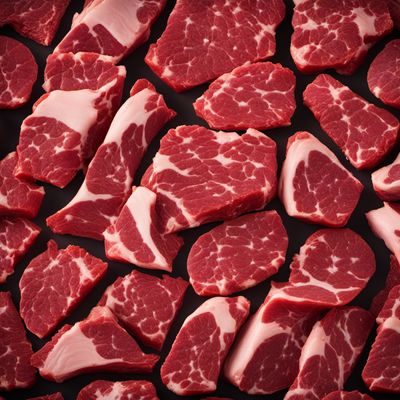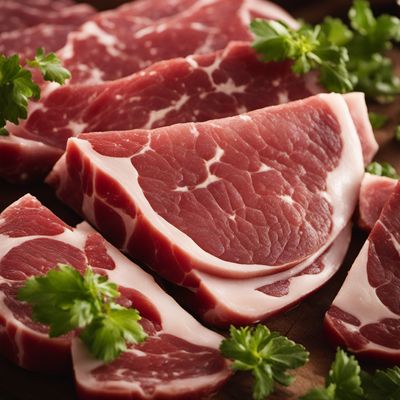
Ingredient
Bovine fresh meat
The Prime Cut: Bovine Fresh Meat
Bovine fresh meat comes from cattle and is known for its rich, savory flavor and tender texture. It can vary in color, ranging from bright red to deep maroon, depending on the age and cut of the meat. The marbling of fat within the meat contributes to its tenderness and juiciness. Bovine fresh meat is a protein powerhouse, packed with essential nutrients like iron, zinc, and B vitamins.
Origins and history
The consumption of bovine meat dates back thousands of years, with evidence of cattle domestication as early as 10,000 years ago. Throughout history, bovine meat has played a significant role in various cultures and cuisines, from the succulent steaks of Argentina to the hearty stews of Ireland. Today, beef is enjoyed worldwide and is a staple in many traditional and contemporary dishes.
Nutritional information
Bovine fresh meat is a nutrient-dense food, providing high-quality protein, essential amino acids, and important vitamins and minerals. It is particularly rich in iron, zinc, and vitamin B12. However, it is also higher in saturated fat compared to other meats, so moderation is key. The nutritional content can vary depending on the cut of meat and cooking method.
Allergens
Bovine fresh meat may cause allergic reactions in individuals with a beef allergy. It is important to be cautious and consult with a healthcare professional if you suspect an allergy or have a known sensitivity to beef.
How to select
When selecting bovine fresh meat, look for cuts that are bright red in color, with minimal discoloration or browning. The meat should feel firm to the touch and have a fresh, slightly sweet aroma. Choose cuts with marbling, as this indicates tenderness and flavor. If possible, opt for grass-fed or organic beef to support sustainable and ethical farming practices.
Storage recommendations
To maintain the freshness and quality of bovine fresh meat, it should be stored in the refrigerator at a temperature below 40°F (4°C). It is best to keep the meat in its original packaging or wrap it tightly in plastic wrap or aluminum foil to prevent air exposure. Cook or freeze the meat within a few days of purchase to ensure optimal taste and safety.
How to produce
Producing bovine fresh meat requires specialized knowledge and resources. It involves raising cattle in suitable environments, providing proper nutrition, and ensuring their well-being. This process is best left to professional farmers and ranchers who have the expertise and infrastructure to raise cattle responsibly and sustainably.
Preparation tips
Bovine fresh meat can be prepared in various ways, depending on the desired outcome. Grilling, roasting, and pan-searing are popular methods for cooking steaks and other cuts. Slow cooking or braising is ideal for tougher cuts, as it helps tenderize the meat. It is important to let the meat rest after cooking to allow the juices to redistribute, resulting in a more flavorful and tender final product. Use a meat thermometer to ensure proper doneness.
Substitutions
Lamb, pork, bison
Culinary uses
Bovine fresh meat is incredibly versatile and can be used in a wide range of culinary applications. It is commonly used in dishes such as steaks, burgers, roasts, stews, and stir-fries. It pairs well with various flavors and ingredients, including herbs, spices, vegetables, and sauces. Bovine fresh meat is a key component of iconic dishes like beef bourguignon, steak frites, and hamburgers.
Availability
Bovine fresh meat is widely available in most countries around the world, with beef production being a significant industry in countries like the United States, Brazil, Australia, and Argentina.
More ingredients from this category

Cow, ox or bull fresh meat
The Prized Protein: Exploring Cow, Ox, or Bull Fresh Meat

Yak fresh meat
The Exquisite Delicacy of Yak Meat

Buffalo, african fresh meat
The African Delicacy: Fresh Buffalo Meat

Zebu fresh meat
The Exotic Delicacy

Buffalo, american fresh meat
The Mighty Bison

Calf fresh meat
Tender Delight: Exploring the World of Calf Fresh Meat

Bovine, minced meat
Versatile Ground Beef

Buffalo fresh meat
The Lean and Flavorful Protein
